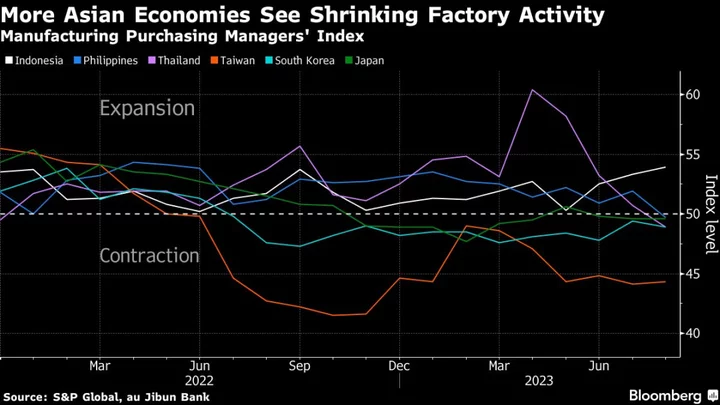Manufacturing activity in Asia’s major export powerhouses slumped further in August as weak demand persisted in the region’s key trade markets, particularly in China.
Factories in North Asia experienced weaker new orders, output and export sales, according to manufacturing purchasing managers’ surveys published Friday by S&P Global and au Jibun Bank.
The purchasing managers’ index for trade bellwether Taiwan was little changed at a subdued level of 44.3 last month from 44.1 in July, while South Korea’s gauge slumped to 48.9 from 49.4 during the same period. Seoul reported a similarly gloomy reading on industrial production on Thursday, showing a bigger-than-expected drop in July, marking its longest stretch of output decline yet.
Japan’s PMI was unchanged at 49.6, below the 50 mark that separates expansion from contraction.
Southeast Asia, which until recently was a bright spot, showed the weak sentiment was rubbing off on factories in the region. The Philippines and Thailand saw their gauges slip into the red for the first time since 2021, pulling back on new orders amid disappointing demand. Malaysia’s reading was unchanged at 47.8, while Indonesia was an outlier, with a region’s best 53.9.
The latest data dashes hopes of an easy turnaround for the region despite increasing signs of a soft landing in the US. The stubborn weakness of goods trade is dampened by the prospect of high borrowing costs in the US and Europe.
Closer to home, China’s economic slowdown is curbing demand for exports in the region. Many Asian economies count China as their biggest trading partner.
China’s manufacturing activity fell for a fifth consecutive month in August, data showed Thursday. However, pickups in new orders and output provided hope the worst of a factory slump dragging on the nation’s economy may be ending.
The headwinds are picking up in the region. Japan grappled with higher raw material prices and labor costs, while South Korea saw a return of shipping delays and semiconductor shortages, S&P Global said. In Taiwan, companies grew pessimistic for the next 12 months, trimming inventories and staff numbers in anticipation of a weaker market ahead.
“Until we see an improvement in global economic conditions, which have been under pressure from stubborn inflation and higher interest rates, it’s unlikely that Taiwan’s manufacturing sector will swing back into growth territory any time soon,” said Annabel Fiddes, economics associate director at S&P Global Market Intelligence.
(Updates throughout with more details)

